|
In This Issue...
- Research Spotlight
- "Science demands from a man all his life. Even if you had two lives that would not be enough." - Ivan Pavlov
- Trending Science
- Women in Science
- Personal Struggles to Personal Success
- Aging and Healthy Brain Initiatives: IBNS Public Outreach in Boca Raton
- Member News
- IBNS at SfN 2018
- 28th IBNS Conference and Upcoming Deadlines
Research Spotlight
Raul R. Gainetdinov
Director of the Institute of Translational Biomedicine
Head of the Laboratory of Neuroscience and Molecular Pharmacology
St. Petersburg State University, Saint-Petersburg, Russia
The trace amines, endogenous monoamines found in the trace concentrations in the brain, have been known and studied for decades. Recently, this topic regained common interest and has become a major focus of my laboratory. The functions of classical monoamines, such as dopamine and serotonin, are well studied. However, the effects of trace amines, which were actually discovered before the classical monoamines, are still unclear. The group of trace amines include beta-phenylethylamine, p-tyramine, tryptamine, p-octopamine, and some of their metabolites, which possess high structural similarity to the well-known monoamine neurotransmitters as well as amphetamine. It was shown that trace amines might modulate the activity of dopamine and serotonin transmission by affecting their transporters in amphetamine-like manner. The picture changed in 2001 when a group of vertebrate G protein–coupled receptors with high selectivity for beta-phenylethylamine, p-tyramine, and p-octopamine was identified. It became clear that trace amines possess their own (not yet studied) functions, which might affect the whole understanding of monoaminergic signaling.
Our investigations are mostly focused on the trace amine associated receptor 1 (TAAR1), which is  the most studied receptor out of the group of 6 functional isoforms of trace amine associated receptors (TAARs) in humans. In the brain, it is localized in discrete regions containing the dopaminergic neurons of the ventral tegmental area, the serotonergic neurons of the dorsal raphe, the amygdala, the prefrontal cortex and several subregions of the basal ganglia. TAAR1 signaling was shown to decrease the firing rate of dopaminergic neurons and dopamine release from terminals. TAAR1 has also been shown to interact with the dopamine D2 receptors both pre- and post-synaptically. Thus, TAAR1 is considered as a potential target for the treatment of neurological and psychiatric diseases associated with the dysregulation of the brain dopamine system, such as schizophrenia, drug addiction, depression. In collaboration with Hoffmann La-Roche, we have observed that the effects of TAAR1 agonists are similar to the effects of antagonists of D2 dopamine receptors. Clinical studies using TAAR1 agonists to treat symptoms of schizophrenia are being performed now. Previous investigations have shown the role of TAAR1 in the regulation of dopaminergic system and its importance in physiological processes such as locomotion, control of emotional states and cognition. Among other findings, we and colleagues have demonstrated potential antipsychotic action in several behavioral paradigms as well as a strong antidepressant-like effect of TAAR1 agonists in the forced swim test. We have also showed that the likely mechanism of such activity of TAAR1 agonists involves the ability of TAAR1 to directly interact with D2 dopamine receptors. Another possible point of applications of TAAR1 is drug abuse. Several groups have shown that TAAR1 agonists can reduce self-administration of various drugs such as cocaine, nicotine, amphetamine, methamphetamine and others. It was also shown that activation of TAAR1 can reduce alcohol consumption. Thus, it might be considered as a very promising target for the treatment of drug abuse as well. the most studied receptor out of the group of 6 functional isoforms of trace amine associated receptors (TAARs) in humans. In the brain, it is localized in discrete regions containing the dopaminergic neurons of the ventral tegmental area, the serotonergic neurons of the dorsal raphe, the amygdala, the prefrontal cortex and several subregions of the basal ganglia. TAAR1 signaling was shown to decrease the firing rate of dopaminergic neurons and dopamine release from terminals. TAAR1 has also been shown to interact with the dopamine D2 receptors both pre- and post-synaptically. Thus, TAAR1 is considered as a potential target for the treatment of neurological and psychiatric diseases associated with the dysregulation of the brain dopamine system, such as schizophrenia, drug addiction, depression. In collaboration with Hoffmann La-Roche, we have observed that the effects of TAAR1 agonists are similar to the effects of antagonists of D2 dopamine receptors. Clinical studies using TAAR1 agonists to treat symptoms of schizophrenia are being performed now. Previous investigations have shown the role of TAAR1 in the regulation of dopaminergic system and its importance in physiological processes such as locomotion, control of emotional states and cognition. Among other findings, we and colleagues have demonstrated potential antipsychotic action in several behavioral paradigms as well as a strong antidepressant-like effect of TAAR1 agonists in the forced swim test. We have also showed that the likely mechanism of such activity of TAAR1 agonists involves the ability of TAAR1 to directly interact with D2 dopamine receptors. Another possible point of applications of TAAR1 is drug abuse. Several groups have shown that TAAR1 agonists can reduce self-administration of various drugs such as cocaine, nicotine, amphetamine, methamphetamine and others. It was also shown that activation of TAAR1 can reduce alcohol consumption. Thus, it might be considered as a very promising target for the treatment of drug abuse as well.
Other TAARs are significantly less studied, but created in our laboratory TAAR knockout mice might uncover the physiological role of them in the nearest future. We believe that the manipulation of TAAR activity might serve as a perspective approach for the treatment of a variety of neuropsychiatric disorders, such as schizophrenia, depression, addiction, and others.
References:
Gainetdinov RR, Hoener MC, Berry MD. Trace Amines and Their Receptors. Pharmacol Rev. 2018 Jul;70(3):549-620.
Schwartz MD, Canales JJ, Zucchi R, Espinoza S, Sukhanov I, Gainetdinov RR. Trace amine-associated receptor 1: a multimodal therapeutic target for neuropsychiatric diseases. Expert Opin Ther Targets. 2018 Jun;22(6):513-526.
Espinoza S, Leo D, Sotnikova TD, Shahid M, Kääriäinen TM, Gainetdinov RR..Biochemical and Functional Characterization of the Trace Amine-Associated Receptor 1 (TAAR1) Agonist RO5263397. Front Pharmacol. 2018 Jun 21;9:645.
Back to Top
Science demands from a man all his life. Even if you had two lives that would not be enough." - Ivan Pavlov
Liubov Kalinichenko, Guest Editor
Department of Psychiatry and Psychotherapy
Friedrich-Alexander University Erlandgen-Nürnberg, Erlandgen, Germany
On September 14th, the 169th birthday of Ivan Pavlov was celebrated, a Russian scientist known for his work in classical conditioning and the physiology of digestion. We consider it as a good reason to refresh our memories about this outstanding scientist and his personality.
 Ivan Pavlov won the fourth in the history Nobel Prize for Physiology or Medicine in 1904 "in recognition of his work on the physiology of digestion, through which knowledge on vital aspects of the subject has been transformed and enlarged.” Pavlov investigated various processes of digestion, in part by exposing sections of a dog's intestinal canal through surgery. He identified the pathways affecting the movements in the intestinal canal as well as secretion intensity and content of gastric juice determined by the nervous system. Pavlov showed that dogs tend to salivate before food is actually delivered to their mouths, and named this phenomenon "psychic secretion.” Ivan Pavlov won the fourth in the history Nobel Prize for Physiology or Medicine in 1904 "in recognition of his work on the physiology of digestion, through which knowledge on vital aspects of the subject has been transformed and enlarged.” Pavlov investigated various processes of digestion, in part by exposing sections of a dog's intestinal canal through surgery. He identified the pathways affecting the movements in the intestinal canal as well as secretion intensity and content of gastric juice determined by the nervous system. Pavlov showed that dogs tend to salivate before food is actually delivered to their mouths, and named this phenomenon "psychic secretion.”
He became the first Russian Nobel laureate. Interestingly, he was nominated for the Nobel Prize over four successive years. He did not win the prize until 1904 as his nominations were based on the fundamental science, but not directly medicine. It is believed that Alfred Nobel knew Pavlov for many years before receiving the Nobel Prize, and the topic of Pavlov’s work was a reason to add physiology to the initially planned prize for medical discoveries.
It should be noted that the life of this outstanding and talented scientist was not easy. Russian scientists were paid very little, so Ivan Pavlov had to finance his researches and employees partly from his own money. That’s why in 1887 he couldn’t afford his apartment anymore and had to spend a few months away from his wife and son, sleeping in his lab. Pavlov was earning money for his researches by many ways, including selling canine gastric juice he drew from lab dogs to patients with dyspepsia in Europe. Even after he got the Nobel Prize, he struggled with money problems in his lab. For example, he agreed to become a member of the Russian Academy of Sciences only if his academic salary was allowed to be used to get an additional research technician.
Testimonies of contemporaries point out the explosive temper of Ivan Pavlov. Students and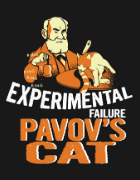 coworkers had their favorite stories about the “spontaneous morbid paroxysms,” as he put it. However, it should be noted that he loved his experimental animals. Pavlov believed that dogs had thoughts, emotions and personalities. His lab dogs were given names in accordance to their characters and were routinely described in lab books as heroic or cowardly, smart or obtuse, weak or strong, good or bad workers, etc. coworkers had their favorite stories about the “spontaneous morbid paroxysms,” as he put it. However, it should be noted that he loved his experimental animals. Pavlov believed that dogs had thoughts, emotions and personalities. His lab dogs were given names in accordance to their characters and were routinely described in lab books as heroic or cowardly, smart or obtuse, weak or strong, good or bad workers, etc.
The stubbornness and outstanding talent of Ivan Pavlov brought him the Nobel Prize as well as acceptance in the whole world. The Pavlov Institute of Physiology of the Russian Academy of Sciences in Saint Petersburg was founded by Pavlov in 1925, and named after him following his death. A few museums devoted to his experiments and life are located in Russia. Moreover, the asteroid 1007 Pawlowia and the lunar crater Pavlov were also named after him. Pavlov devoted all his life to science and thus, the memories of him will stay over generations.
References:
1https://www.nobelprize.org; 2https://www.wikipedia.org; 3Reagan, Leslie A.; et al., eds. (2007). Medicine's moving pictures. Rochester, NY: University of Rochester Press. p. 285; 4Schmadel, Lutz D. (2007). Dictionary of Minor Planet Names – (1007) Pawlowia. Springer Berlin Heidelberg. p. 87.
Back to Top
October Newsletter vol 22-9 Guest Editors:
Ben Tsang
University of Toronto Mississauga
Mississauga, Canada
and
Liubov Kalinichenko
Friedrich-Alexander University Erlandgen-Nürnberg
Erlandgen, Germany
Thank you!
Interested in serving as a Guest Editor for the IBNS News?
Email: [email protected]
Looking for a New Employment Opportunity or Struggling to Find the Right Candidate? Meet the IBNS Career Center!
One of the biggest challenges for any international scientific society is to provide quality and informative support to its members, whether it's for a new employment opportunity or finding the right candidate for a newly opened position. The IBNS online Career Center portal (http://jobs.ibnsconnect.org) provides the right tools for both job seekers and employers.

The IBNS Career Center portal offers all the standard operational features; such as a thorough search engine by keyword and location, as well as a free review of your resume for feedback, and a job-posting service for employers. However, what makes the IBNS Career Center stand out in terms of support is two additional quality features: resources for job seekers & access to a resume bank for employers.
In the Resources section, you have access to a number of articles with valuable tips in building a resume, job seeking, and communication. These tips come from experienced scientists in the field -- not only for searching or applying for a position, but also for the interview process. Interested in 'building your brand’ or strengthening your social media presence? You will find plenty of advice and tips to do so, which will help strengthen your image and move your career to the direction you want!
 In the Resume Bank, potential employers have free access to a large bank of resumes and profiles. You can customize the filters that apply to your search and create lists of candidates that fulfill your own criteria. In the Resume Bank, potential employers have free access to a large bank of resumes and profiles. You can customize the filters that apply to your search and create lists of candidates that fulfill your own criteria.
Back to Top
Trending Science
In this column, we share the latest research, interesting scientific articles and news.
Nobel Prize in Physiology or Medicine, 2018
Liubov Kalinichenko, Guest Editor
Department of Psychiatry and Psychotherapy
Friedrich-Alexander University Erlandgen-Nürnberg, Erlandgen, Germany
Cancer kills millions of people every year and is one of greatest challenges for modern medicine. This year the Nobel Prize went to two outstanding scientists, James P. Allison and Tasuku Honjo, who have established an entirely new principle for cancer therapy based on the stimulation of the immune system. Allison and Honjo have developed two different approaches for inhibiting the brakes on the immune system, which can be used in the treatment of cancer.
In the recent decades, the idea that the activation of immune system might be a perspective strategy for attacking tumor cells has developed. Attempts were made to infect patients with bacteria to activate the defense, but they were not very successful. A variant of this approach is used now, but limited to the treatment of bladder cancer. Thus, it was clear that a deeper understanding of the basic mechanisms of the immune response to cancer should be developed. Remarkable scientific progress of the recent years showed how the immune system can recognize cancer cells.
The fundamental property of our immune system is the ability to discriminate “self” from “non-self” stimuli by T-cells, a type of white blood cells. This allows invading bacteria, viruses, and other dangers to be attacked and eliminated. It was observed that T-cells have receptors binding to “non-self” structures in order to trigger the defensive function of the immune system. Importantly, additional proteins acting as T-cell accelerators are also required to trigger a full-blown immune response.
Allison discovered that a particular T-cell protein, CTLA-4, acts as a braking system, preventing full activation of the immune system during cancer development. He investigated whether CTLA-4 blockade could disengage the T-cell brake and unleash the immune system to attack cancer cells. Experiments on mice with cancer show high therapeutic properties of the antibodies against CTLA-4, which block the function of the brake leading to activation of T cells and attack on cancer cells. In 2010, a clinical study showed striking effects of the antibodies against CTLA-4 in patients with advanced melanoma. In several patients, signs of remaining cancer disappeared.
A similar approach was developed by Honjo, who discovered PD-1, another protein expressed on the surface of T-cells. PD-1 is another T-cell brake that inhibits the T-cell activation. Antibodies against PD-1 inhibit the function of the brake leading to the activation of T-cells and highly efficient attack on cancer cells. Animal and clinical studies have shown that PD-1 blockage by the antibodies is a promising strategy for the treatment of different types of cancer. The results of clinical studies were dramatic, leading to long-term remission and possible cure in several patients with metastatic cancer.
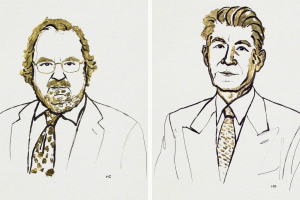 Of the two treatment strategies, the therapy against PD-1 seems to be more against several types of cancer, such as: lung cancer, renal cancer, lymphoma and melanoma. Combination therapy based on the antibodies to both CTLA-4 and PD-1 is shown to be even more effective, as demonstrated in patients with melanoma. Thus, Allison and Honjo have inspired efforts to combine different strategies to release the brakes on the immune system to increase the efficiency of tumor cell elimination. A large number of clinical trials targeting the new checkpoint proteins are currently underway against most types of cancer. Checkpoint therapy has now revolutionized cancer treatment and has fundamentally changed the approach of how cancer can be handled. Of the two treatment strategies, the therapy against PD-1 seems to be more against several types of cancer, such as: lung cancer, renal cancer, lymphoma and melanoma. Combination therapy based on the antibodies to both CTLA-4 and PD-1 is shown to be even more effective, as demonstrated in patients with melanoma. Thus, Allison and Honjo have inspired efforts to combine different strategies to release the brakes on the immune system to increase the efficiency of tumor cell elimination. A large number of clinical trials targeting the new checkpoint proteins are currently underway against most types of cancer. Checkpoint therapy has now revolutionized cancer treatment and has fundamentally changed the approach of how cancer can be handled.
References: 1https://www.nobelprize.org
Back to Top
Women in Science
Samantha Mahabir, PhD
University of Toronto Mississauga, Mississauga, Canada
I was the first of my family to complete a Bachelor’s degree, which was a huge accomplishment, at least for me. When I decided that I wanted to pursue a graduate degree in neuroscience, most of my friends and family paused. The first question they asked was, Well, when are you planning on getting married and having children? I knew one day I would want to find my Prince Charming, put on that white dress, and have a dozen kids, but I also knew that I wanted to be an accomplished neuroscientist. My family believed that if I was going to pursue a graduate degree in science, then I would have to give up on those dreams of being married with kids because only the successful female scientists are the ones who give all their time and devotion to their work. With that encouragement in mind, I still decided to tackle my dream.
For the first three years of my graduate degree it was exactly what my family said, all of my time and efforts were dedicated to examining the effect of embryonic alcohol on the brain in zebrafish and I was very successful at doing it. As I started to wrap up my thesis, there he was, my Prince Charming, and before you knew it I was married with baby Mason on the way. Everyone thought…okay that’s it, their goes all her hard work out the door. But I was determined to prove them wrong. I took a very short maternity leave of approximately eight months and went back to the lab! My parents were helpful with watching my son but there was a week when I turned my office into a daycare! Things did change though and I did experience many struggles. For instance, the biggest struggle for me was time. I barely had time for myself, let alone graduate work. I could no longer have sleepovers at the lab or stay up all night reading articles. Instead, I was sleep deprived and trying to remember if I had anything to eat for the day. I’ll admit I even had break downs where I thought I wouldn’t finish. But as I continued to write my thesis I started to develop a routine, a routine was important for both my success as a scientist and as a mom. Having good supporters like my mom was amazing too! I now worked Monday to Friday 12-4:00 PM opposed to 24/7 because I knew that was when my brain peaked in efficiency.
About 75% through my dissertation, I became pregnant with baby Michelle. At this point I felt like giving up. Not only did I have an energetic one and a half year old who was curious about everything, in addition to trying to finish my dissertation, but I was also instructing two courses (I needed 600 hours to get financial aid on maternity leave, plus I don’t like my husband paying for everything). Baby Michelle was born April 2, 2018, and I managed to wrap up my thesis writing by June. I remember editing my thesis with one hand and holding Michelle with the other hand.
Most people thought I was doing the impossible and set myself up for failure, but I managed   to overcome my challenges. I completed my dissertation in August 2018 and I have two amazing children and a wonderful husband. When my family ask how I managed, I usually tell them that they were great supporters with the kids, I found a good writing environment, I learned my energy levels and when I would be productive, and I also told them I barely cooked. I am still on maternity leave, now trying to find a job. Most of these jobs want an individual who can multi-task; I always feel the need to hand in a resume that says I completed my PhD in seven years, two of which are maternity leaves. to overcome my challenges. I completed my dissertation in August 2018 and I have two amazing children and a wonderful husband. When my family ask how I managed, I usually tell them that they were great supporters with the kids, I found a good writing environment, I learned my energy levels and when I would be productive, and I also told them I barely cooked. I am still on maternity leave, now trying to find a job. Most of these jobs want an individual who can multi-task; I always feel the need to hand in a resume that says I completed my PhD in seven years, two of which are maternity leaves.
My personal advice to anyone who wants to pursue a career in science and have a family is that it definitely is possible but you need to plan ahead! Make a list of all of your supporters, people you trust to watch your kids so that you can have an ease of mind while at work. If you don’t have many supporters, look into daycare and do it well in advance as there is usually a wait list. The next big thing is to know yourself. Understand your work habits; for example, do you work best at home or at the library? When are you most productive, in the morning or at midnight? I also had an agenda for each day. This was my biggest aid in being successful, I created a to-do list for both work and family.
The truth is there is no perfect time for pursuing a career in science or having a family, if you keep thinking about having both as being impossible you will never allow it to happen. I believe anything is possible with the right planning and state of mind.
Back to Top
Personal Struggles to Personal Success
Tyler Pacheco
Zovkic Lab, Department of Psychology
University of Toronto Mississauga, Mississauga, Canada
Weekend Volunteer Team Lead, Pride Toronto
The process that has led me to the person I am today has been a roller-coaster of many highs and lows. This includes experiences like joining my first lab at the University of Toronto Mississauga, taking my graduating pictures before completing my last year of undergraduate studies, and “coming out” to my family and friends prior to my first year of undergraduate studies. Although I had the support of everyone through this process, navigating society and academia caused me to question whether my identity would act as a barrier in my pursuit of science.
Growing up as a gay man within the LGBTQ+ community has been a blessing. I have taken on a role as a Team Lead for Pride Toronto in order to help create a positive space for others. Through this experience, my main role is to recruit, register and process an average of 1,500 volunteers for Pride Toronto’s festival weekend. This amazing opportunity has not only allowed me to become integrated within the community I identify with, but has also built my skill set for the years to come.

Through the experiences I have faced, whether discriminatory or constructive, it is important to utilize these as moments of learning. In doing so, the discriminatory acts I have faced have been used to build a thicker skin. To me, this has built me as a young scientist as I am able to handle harsher forms of criticism on my research process or keeping a level head when I make mistakes. This has further aided in making me a better scientist as you must look past the negative in order to achieve success. By turning a blind eye to these acts of discrimination and words of hate, the barriers I once associated with my identity held no significance. Building a thicker skin further aided in this process because my failure and success was never rooted within how I identify. By continuously developing myself as a young gay scientist, it was a way to prove myself and others that anyone can be successful.
Since my story began as an openly gay academic in first year, I have undergone a form of metamorphosis. I began to realize that I should not apologize for the person I am, nor should I fear how my academic abilities are perceived based on how I identify. Rather, I stand for who I am whether I am with the people closest to me, or the team I work with within research facilities. The challenges I have faced personally have strengthened my resolve to succeed, to pursue science with my fellow colleagues, and to improve myself over time.
Lastly, I would like to thank IBNS for the opportunity to share my perspective on what it is like to be a young gay scientist. The society provides such an asset for individuals who have similar research interests as well as a platform for members who wish to network over similar experiences.
Back to Top
Aging & Healthy Brains Initiative: IBNS Public Outreach in Boca Raton
Cindy Barha, Postdoctoral Fellow
University of British Columbia, Vancouver, Canada
and Patricia de la Tremblaye, Postdoctoral Fellow
University of Pittsburgh, Pittsburgh, Pennsylvania
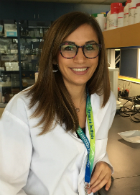 This year’s IBNS public outreach was a great success! We delivered several DVD copies of the Otago Exercise Program to three assisted living communities in Boca Raton. The Otago Exercise Program is a home-based, individually tailored strength and balance retraining program that reduces falls by over 35% and improves cognitive functioning in older adults. We would like to thank the Aging, Mobility, and Cognitive Neuroscience Lab (University of British Columbia) for generously donating the Otago DVDs. This year’s IBNS public outreach was a great success! We delivered several DVD copies of the Otago Exercise Program to three assisted living communities in Boca Raton. The Otago Exercise Program is a home-based, individually tailored strength and balance retraining program that reduces falls by over 35% and improves cognitive functioning in older adults. We would like to thank the Aging, Mobility, and Cognitive Neuroscience Lab (University of British Columbia) for generously donating the Otago DVDs.
 Following the success of this year’s public outreach, we are looking to expand the Aging and Healthy Brains Initiative to include more senior centers, assisted living communities, and other activities at future IBNS meetings. As IBNS continues to grow, giving back to the community is a vital endeavour. Please stay tuned for further details about the Aging and Healthy Brains Initiative, as well as opportunities to contribute to next year’s public outreach. And if you have an idea for a fundraiser or outreach event, please contact the IBNS Council! Following the success of this year’s public outreach, we are looking to expand the Aging and Healthy Brains Initiative to include more senior centers, assisted living communities, and other activities at future IBNS meetings. As IBNS continues to grow, giving back to the community is a vital endeavour. Please stay tuned for further details about the Aging and Healthy Brains Initiative, as well as opportunities to contribute to next year’s public outreach. And if you have an idea for a fundraiser or outreach event, please contact the IBNS Council!
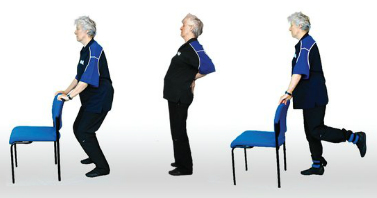

Back to Top
Member News
Ben Tsang, Guest Editor
University of Toronto Mississauga, Mississauga, Canada
Featuring: Caroline Blanchard, PhD
Professor Emeritus, University of Hawaii at Manoa
Visiting Professor at the University of Sao Paulo
I am happily ensconced in Brazil, in the Department of Anatomy of the Institute of Biomedicine at the University of Sao Paulo; and working on two projects that are dear to my heart.
First: Newton Canteras and I are examining the behaviors and neural circuitry of risk assessment in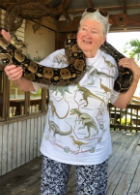 rats, using snakes as threat stimuli. Our preliminary work suggests that lab rats show substantial and persistent risk assessment, but surprisingly low levels of flight or freezing, to snakes of Brazilian origin, unless the snake strikes at them. This suggests that a detailed comparison between behaviors elicited and patterns of brain system activation can provide information on this translationally important defensive behavior, that is typically obscured when more conventional threat stimuli are activated. We are currently advertising for a post-doctoral fellow for this project (see upcoming Ad in Nature), so if interested please send me an email at [email protected]. rats, using snakes as threat stimuli. Our preliminary work suggests that lab rats show substantial and persistent risk assessment, but surprisingly low levels of flight or freezing, to snakes of Brazilian origin, unless the snake strikes at them. This suggests that a detailed comparison between behaviors elicited and patterns of brain system activation can provide information on this translationally important defensive behavior, that is typically obscured when more conventional threat stimuli are activated. We are currently advertising for a post-doctoral fellow for this project (see upcoming Ad in Nature), so if interested please send me an email at [email protected].
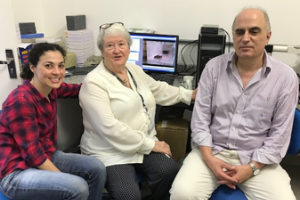 Second: Working with Simone Motta to try to get a more precise view of the dyadic interactions involved in fighting in mice. We are interested in studying which aspects of the resident-intruder situation are important for neural organization of social defense, i.e. conspecific information and environmental entrapment. We are concerned about how the nervous system perceives these situational differences leading to diversity in behavioral outcomes. Because of the behavioral complexity and speed of dyadic mouse interactions, we are using an ultrafast camera to give us information on the aims and postures involved. Second: Working with Simone Motta to try to get a more precise view of the dyadic interactions involved in fighting in mice. We are interested in studying which aspects of the resident-intruder situation are important for neural organization of social defense, i.e. conspecific information and environmental entrapment. We are concerned about how the nervous system perceives these situational differences leading to diversity in behavioral outcomes. Because of the behavioral complexity and speed of dyadic mouse interactions, we are using an ultrafast camera to give us information on the aims and postures involved.
Both of these are long-term projects so I plan to be here for four months/year for this, and the next three years.
An interesting extension to all this is that a documentary film maker and I may go to South Africa and India next year, to photograph relevant species in natural habitats, with a view to checking out some of the hypotheses emerging from these projects.
Back to Top
IBNS at SfN 2018
IBNS will be at the 2018 Society for Neuroscience (SfN) Meeting in San Diego, California, November 3-7.
If you're planning to attend, we would love to see you at the IBNS (un)booth #4133! Why is IBNS the (un)booth? Because we aren't like anyone else! Take this opportunity to learn more about the 2019 Annual Meeting in Cairns, Australia. Or, just relax and get off your feet, take a seat, and meet and network with IBNS members!
Also during SfN, the IBNS reception will be held on Sunday, November 4, from 6:30pm - 8:30pm at the Grand Hyatt, Harbor Ballroom A. Wear your IBNS Cairns sunglasses, IBNS lanyard, or your clip-on koala (all given at the last annual meeting) to receive a FREE DRINK TICKET! But don't be late! Drink tickets will only be given to the first 75 people upon arrival.
Missed the last meeting? No worries! Stop by the IBNS booth #4133 to pick up these Cairns goodies!*
There will be light food, drinks, and plenty of networking opportunities. Join us, bring some friends, and catch up with your IBNS family!
*while supplies lasts


Back to Top
28th Annual IBNS Conference and Upcoming Deadlines
Save the date for this must-attend event! June 23 - 27, 2018, the 28th Annual IBNS Meeting is in Cairns, Australia.
Upcoming deadlines:
December 16, 2018: Travel Award Applications Due
February 1, 2019: Abstract Submissions Due (Oral/Poster)
June 23-27, 2019: Conference Dates

Be sure to keep checking the IBNS 2019 meeting page for frequent updates.
Back to Top
Do you have an interesting hobby or member news to share?
Let us know at [email protected]
|